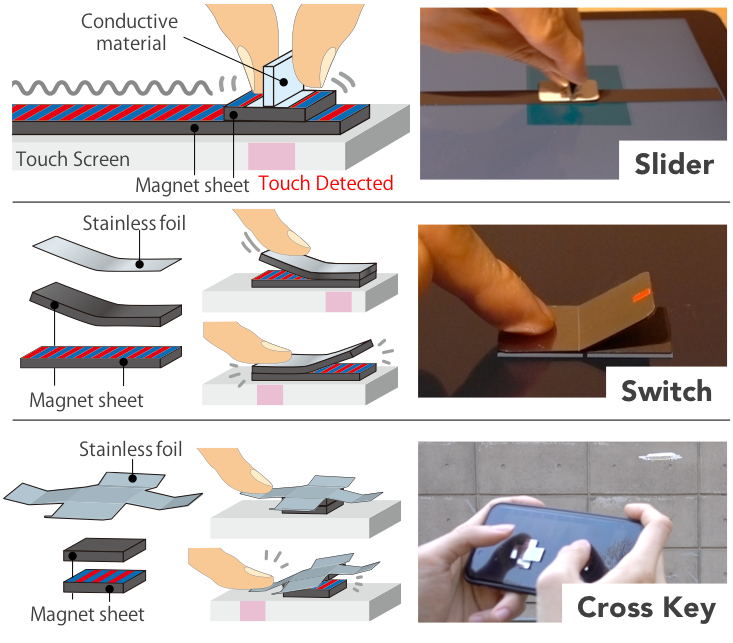“Magnetact: Magnetic-Sheet-Based Haptic Interfaces for Touch Devices”
Conference:
Experience Type(s):
Title:
- Magnetact: Magnetic-Sheet-Based Haptic Interfaces for Touch Devices
Organizer(s)/Presenter(s):
Description:
This paper presents a rapid prototyping method of haptic interfaces for touch devices utilizing magnetic rubber sheets and conductive materials. When a magnetic sheet is thin enough, the capacitive sensor of the touch device can detect the user’s finger behind the magnetic sheet due to the sheet’s dielectric behavior. Furthermore, by changing the magnetic pattern of the magnetic sheet using a handy magnetizing tool, the tactile feedback can be customized within seconds. Since the construction of the interface is so simple, this method enables users to customize not only the size and shape, also the haptic feedback of the tangible interface. We demonstrated several types of interface such as buttons, sliders, switches, and cross-keys.
References:
[1]
Florian Born. 2013. Modulares Interface. http://florianborn.com/projects/modulares-interface
[2]
Neng-Hao Yu, Sung-Sheng Tsai, I-Chun Hsiao, Dian-Je Tsai, Meng-Han Lee, Mike Y. Chen, and Yi-Ping Hung. 2011. Clip-on gadgets: expanding multi-touch interaction area with unpowered tactile controls. In Proceedings of the 24th annual ACM symposium on User interface software and technology (UIST ’11). ACM, New York, NY, USA, 367–372.
[3]
Neng-Hao Yu, Li-Wei Chan, Seng Yong Lau, Sung-Sheng Tsai, I-Chun Hsiao, Dian-Je Tsai, Fang-I Hsiao, Lung-Pan Cheng, Mike Chen, Polly Huang, and Yi-Ping Hung. 2011. TUIC: enabling tangible interaction on capacitive multi-touch displays. In Proceedings of the SIGCHI Conference on Human Factors in Computing Systems (CHI ’11). ACM, New York, NY, USA, 2995–3004.
[4]
Kentaro Yasu. 2017. Magnetic Plotter: A Macrotexture Design Method Using Magnetic Rubber Sheets. In Proceedings of the 2017 CHI Conference on Human Factors in Computing Systems (CHI ’17). ACM, New York, NY, USA, 4983–4993.
[5]
Masaaki Fukumoto and Toshiaki Sugimura. 2001. Active click: tactile feedback for touch panels. In CHI ’01 Extended Abstracts on Human Factors in Computing Systems (CHI EA ’01). ACM, New York, NY, USA, 121–122.
[6]
Sunjun Kim and Geehyuk Lee. 2013. Haptic feedback design for a virtual button along force-displacement curves. In Proceedings of the 26th annual ACM symposium on User interface software and technology (UIST ’13). ACM, New York, NY, USA, 91–96.
[7]
Liwei Chan, Stefanie Müller, Anne Roudaut, and Patrick Baudisch. 2012. CapStones and ZebraWidgets: sensing stacks of building blocks, dials and sliders on capacitive touch screens. In Proceedings of the SIGCHI Conference on Human Factors in Computing Systems (CHI ’12). ACM, New York, NY, USA, 2189–2192.
[8]
Kentaro Yasu and Yuichiro Katsumoto. 2015. Bump ahead: easy-to-design haptic surface using magnet array. In SIGGRAPH Asia 2015 Emerging Technologies (SA ’15). ACM, New York, NY, USA, Article 3, 3 pages.
[9]
Clement Zheng and Ellen Yi-Luen Do. 2018. Mechamagnets: Tactile Mechanisms with Embedded Magnets. In Proceedings of the Twelfth International Conference on Tangible, Embedded, and Embodied Interaction (TEI ’18). ACM, New York, NY, USA, 57–64.
[10]
Correlated Magnetics. Polymagnet.com. 2016. http://www.polymagnet.com/





